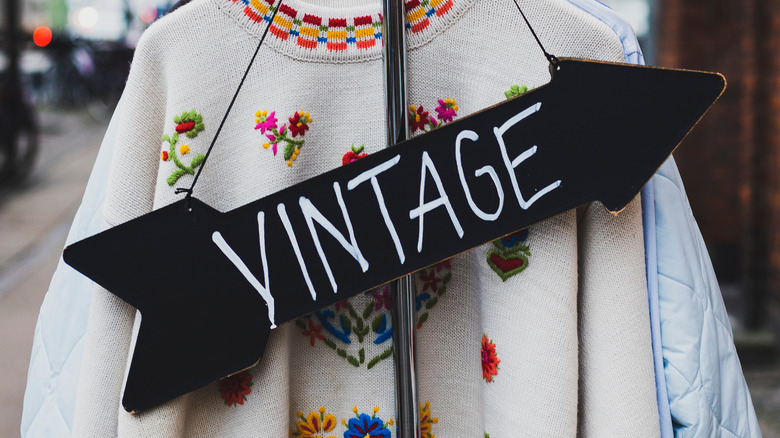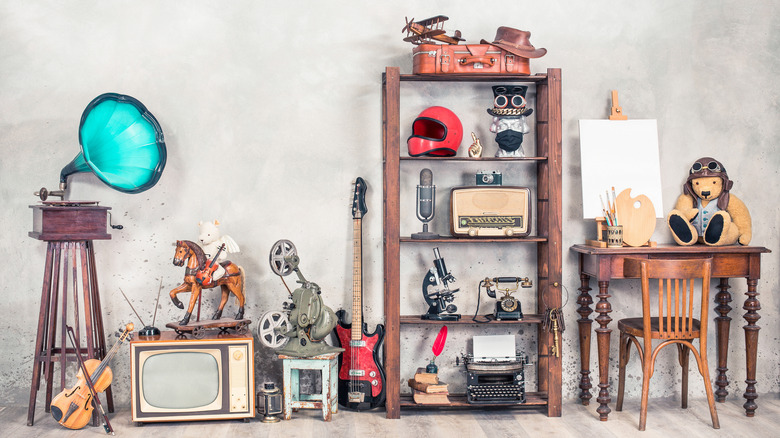How To Tell If A Vintage Piece Is Severely Overpriced
If you're an avid shopper, you probably count finding unique looks as one of your favorite hobbies. There are few things better than taking a whole day just for yourself and some shopping. While you might usually shop at your standard mall, or at boutiques near your home, you might also love to shop for vintage finds. Shopping for vintage pieces is more like a treasure hunt, since each piece is practically one of a kind, and much rarer than mass-produced items at standard stores. These pieces tell a story and have a deep past that might go back 20, 30, or even 60 years — very much depending on your chosen time period, whether going for '60s Woodstock-style hippie glam, or '90s minimalism. Vintage home shopping is just the same, and who doesn't love the idea of filling up an entire home with found treasures?
Still, vintage shopping works best when you know exactly what you're doing, and you've trained yourself to separate the dazzling from the just bad. Not all vintage is created equal, and sometimes the high prices at boutiques are off-putting to say the least, especially for cheap fabrics or off-brand labels. If you've ever struggled with vintage store prices, we have the whole lowdown on to how tell if a vintage piece is severely overpriced.
It has a cheap build or feel
First off, the biggest sign to watch out for when wary of the price of a vintage item is the construction of the garment or item. Just like with anything else, an expensive clothing or homeware item should show its high price tag due to an incredible attention to detail, pointing at a large amount of time spent making it. You should always get what you pay for, so a luxury price tag at a vintage boutique should mean that the item in question isn't just rare — but that it will continue to stand the test of time still and look good.
As explained by Fruit Cocktail Collectibles, there are several details to watch out for when figuring out the correct price of a vintage item. One of the most important aspects to look at in an item is its build: If looking at a piece of clothing, watch out for high-quality details like metal zippers (not invisible zippers), bias hem tape, pinked seams, and snap closures. Similarly, the feel of the fabric should scream quality, and you'll get more of your money's worth if investing in an item with an expensive fabric like silk, wool, or cashmere.
It is much cheaper on eBay or other websites
One of the most crucial things to look for in a vintage item when wondering if it's overpriced is its intrinsic value, and what its price is at other retailers. As per Fruit Cocktail Collectibles, you should always ask about the item you're interested in, and try to get all the information possible from a seller. Clothing items that are pre-'60s are usually more expensive by nature, and will usually have been made in the U.S., France, Italy, or Hong Kong. Similarly, according to Chron.com, designer handbags should come with a serial number, and glassware should also have a brand at the bottom. These vintage pieces usually feel more high-quality than modern items, and can easily be separated from most items you find at your average thrift store.
If you've inspected your item for labels and have already figured out how expensive its materials are, it's time to do a little research. If you love the item and don't want to pass it up by running home and risking someone buying it from under you, simply do the research quickly on your phone. As explained by Offbeat Bride, you should always look on eBay and compare the prices to the item you want to buy at the shop — you might be surprised at the differences in price. Once you know its market value, it's time to negotiate!
It doesn't have a label, is off-trend, or is damaged
Of course, there are many other ways to figure out if an item at a vintage store is overpriced. First off, look at the brand: An expensive vintage item doesn't necessarily have to be a Fendi, Gucci, or Prada piece to be valuable, but it should have a label. It's even better if you recognize it. As per Dummies, vintage shopping is largely about the "RADAR" acronym: rarity, aesthetics, desirability, authenticity, and really good condition. If the item you loved at a vintage store has a designer label, or is at least from a high-quality brand, then you already have a sense of rarity, aesthetics, and desirability. This of course makes it more intrinsically valuable, so you can feel comfortable forking over your hard-earned cash.
Still, it's not just about the brand. You may just fall in love with a wool cardigan, without a label, that was hand-knit back in the 1960s, and who doesn't love the idea of that? If that's your case, not to fret — there are still several ways to figure out if your item is inherently as expensive as its high price tag. Always think about if the item you like is on trend. For example, per Vox, Y2K fashion is in high demand now, so it is naturally pricier at the moment. Also, any expensive vintage item should be in fantastic condition, with no holes or stains, according to Chron.com.



